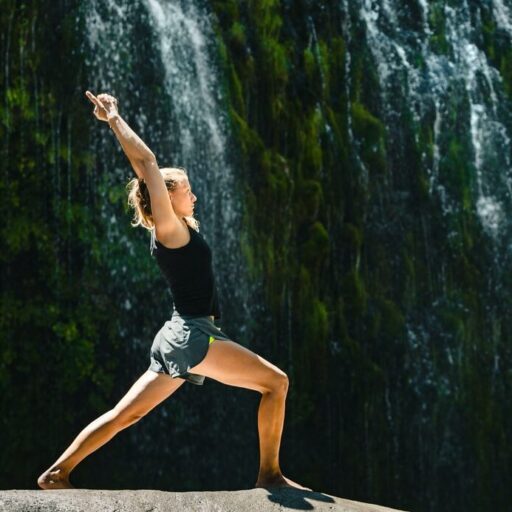Support our educational content for free when you purchase through links on our site. Learn more
Fitness & Environment: 10 Ways Nature Boosts Your Workout 💪

Ever notice how a run in the park feels different from one on a treadmill? It’s not just the scenery; your environment profoundly impacts your fitness. This article dives deep into the fascinating relationship between physical activity and your surroundings, exploring everything from walkable neighborhoods to the psychological benefits of green spaces. We’ll uncover how urban planning, air quality, and even technology influence your workouts, and offer practical tips to optimize your fitness journey in harmony with nature. Ready to discover how your environment can supercharge your fitness results? Let’s get started!
Did you know that people living in walkable neighborhoods tend to be more physically active? It’s true! The design of our cities and towns significantly influences how much we move. This article will show you how to leverage your environment to boost your fitness and well-being.
Key Takeaways
- Your environment significantly impacts your fitness: From the design of your neighborhood to the air quality, your surroundings influence your motivation, enjoyment, and even safety during exercise.
- Walkable neighborhoods and green spaces are crucial: Easy access to parks, trails, and walkable streets encourages more physical activity.
- Environmental barriers like traffic and pollution can hinder fitness: Be mindful of these challenges and adjust your routine accordingly.
- Technology can enhance your outdoor fitness: Fitness trackers and apps can help you monitor your progress and explore new areas.
- Creating fitness-friendly environments is a shared responsibility: Advocate for policies that support active transportation, green spaces, and safe streets.
👉 Shop for sustainable fitness gear: Amazon | Etsy | REI
Table of Contents
The Evolutionary History of Fitness and Environment
Understanding the Built Environment’s Impact on Physical Activity
- Walkability and Its Influence on Fitness
- The Role of Green Spaces in Promoting Physical Activity
- Navigating Environmental Barriers: Traffic, Air Pollution, and Heat
- Designing Fitness-Friendly Neighborhoods: A Holistic Approach
- The Impact of Urban Planning on Physical Activity Levels
- Accessibility and Inclusivity in Fitness Environments
- Technology and the Environment: Fitness Trackers and Outdoor Activities
- Personalizing Your Fitness Journey Based on Your Environment
- Overcoming Environmental Challenges to Achieve Fitness Goals
- The Future of Fitness and the Environment: Sustainable Practices
Environmental Psychology and its Relation to Exercise
Measuring the Impact: Research and Data on Environment and Fitness
Case Studies: Successful Environmental Interventions for Fitness
Frequently Asked Questions about Fitness and the Environment
Quick Tips and Facts
Let’s kick things off with some quick wins to boost your fitness in harmony with nature! 🌳🏃♀️
- Did you know? Spending time in nature can significantly reduce stress and improve your mood, making exercise more enjoyable! Source: American Psychological Association
- Tip: Choose a park, trail, or beach for your workout. The change of scenery can work wonders! Check out these 12 Green Exercise Examples to Boost Your Well-being 🌿 at https://www.fitnessandnature.com/green-exercise-examples/.
- Fact: Studies show that people living in walkable neighborhoods tend to be more physically active. Source: CDC
- Safety First! Always be aware of your surroundings, especially when exercising outdoors. Let someone know your route and estimated return time.
- Hydration is Key: Carry water, especially during hot weather. Dehydration can seriously impact your workout.
The Evolutionary History of Fitness and Environment
Our ancestors weren’t hitting the gym; their fitness was intertwined with their environment. Think about it – hunting, gathering, navigating terrain… it was all about movement and adaptation to the natural world. This inherent connection between our bodies and the environment is still relevant today! Our bodies thrive when we engage in activities that mimic our evolutionary past. We’re built for movement, and nature provides the perfect playground.
Understanding the Built Environment’s Impact on Physical Activity
The way our cities and towns are designed massively impacts how much we move. Think sprawling suburbs versus walkable city centers. This is where the concept of the “built environment” comes in. It encompasses everything from sidewalks and parks to public transportation and street design. A poorly designed built environment can actively discourage physical activity, while a well-designed one can encourage it. Let’s delve deeper into the specifics:
1. Walkability and Its Influence on Fitness
Walkability is all about how easy it is to get around on foot. A high walkability score means shorter blocks, good sidewalks, plenty of destinations within walking distance, and a safe environment. Studies consistently show a strong correlation between walkable neighborhoods and higher levels of physical activity. Source: National Walkable Communities Think about it – if it’s easy and safe to walk, you’re more likely to do it!
2. The Role of Green Spaces in Promoting Physical Activity
Parks, greenways, and other natural areas are not just aesthetically pleasing; they’re crucial for our physical and mental well-being. Access to green spaces is strongly linked to increased physical activity levels. People are more likely to exercise outdoors if there are inviting and accessible green spaces nearby. Source: American Heart Association Plus, the beauty of nature itself can make exercise more enjoyable and less of a chore!
3. Navigating Environmental Barriers: Traffic, Air Pollution, and Heat
Unfortunately, not all environments are created equal. Traffic, air pollution, and extreme heat can significantly hinder our ability to be active outdoors. Heavy traffic can make walking or cycling unsafe, while poor air quality can impact respiratory health. Extreme heat can lead to heatstroke and other health problems. We need to be mindful of these risks and adjust our exercise routines accordingly. This might involve choosing different times of day to exercise, opting for indoor activities when necessary, or using air quality apps to track pollution levels.
4. Designing Fitness-Friendly Neighborhoods: A Holistic Approach
Creating truly fitness-friendly neighborhoods requires a holistic approach. It’s not just about building parks; it’s about integrating active transportation options, ensuring safety, and creating aesthetically pleasing environments that encourage people to get out and move. This includes things like:
- Safe and well-maintained sidewalks and bike paths.
- Mixed-use zoning that brings shops, services, and recreational facilities closer to homes.
- Green spaces strategically placed throughout the neighborhood.
- Traffic calming measures to reduce speed and improve safety for pedestrians and cyclists.
5. The Impact of Urban Planning on Physical Activity Levels
Urban planning plays a pivotal role in shaping our physical activity levels. Cities designed with walkability and green spaces in mind encourage more physical activity, while sprawling, car-dependent cities often lead to sedentary lifestyles. This is why advocating for better urban planning is crucial for public health. We need to push for policies that prioritize active transportation, green spaces, and mixed-use development.
6. Accessibility and Inclusivity in Fitness Environments
Fitness environments should be accessible and inclusive for people of all abilities and backgrounds. This means providing ramps, accessible trails, and inclusive fitness equipment. It also means considering the needs of diverse populations, such as older adults, people with disabilities, and those from lower socioeconomic backgrounds. Creating inclusive fitness environments ensures that everyone has the opportunity to benefit from the physical and mental health benefits of exercise.
7. Technology and the Environment: Fitness Trackers and Outdoor Activities
Technology can be a powerful tool for enhancing our fitness journeys, especially when combined with outdoor activities. Fitness trackers can monitor our progress, motivate us to reach our goals, and even provide insights into our environmental exposure. Apps like Strava can track our routes, allowing us to explore new trails and connect with other outdoor enthusiasts. However, it’s important to remember that technology should complement, not replace, the inherent joy and benefits of connecting with nature.
8. Personalizing Your Fitness Journey Based on Your Environment
Your fitness journey should be tailored to your unique environment. If you live in a walkable neighborhood, take advantage of it! If you have access to green spaces, incorporate them into your routine. If you live in an area with poor air quality, adjust your exercise schedule accordingly. By understanding your environment and adapting your fitness plan, you can maximize your results while minimizing risks.
9. Overcoming Environmental Challenges to Achieve Fitness Goals
Environmental challenges shouldn’t derail your fitness goals. If your neighborhood lacks safe walking paths, consider joining a gym or using an indoor fitness app. If air pollution is a concern, exercise indoors or at times when pollution levels are lower. Be creative and find ways to stay active despite environmental limitations. Remember, consistency is key!
10. The Future of Fitness and the Environment: Sustainable Practices
The future of fitness is inextricably linked to environmental sustainability. We need to embrace sustainable practices in our fitness routines, such as choosing eco-friendly fitness gear, reducing our carbon footprint through active transportation, and supporting businesses that prioritize environmental responsibility. By making conscious choices, we can contribute to a healthier planet while pursuing our fitness goals. Learn more about Climate Aware Fitness at https://www.fitnessandnature.com/category/fitness/climate-aware-fitness/.
Environmental Psychology and its Relation to Exercise
Environmental psychology explores the complex interplay between our environment and our behavior. It’s fascinating to see how even subtle aspects of our surroundings can influence our motivation to exercise. For example, a well-maintained park with inviting features is more likely to attract people than a neglected, unsafe space. Understanding these psychological factors is crucial for designing effective fitness interventions and creating environments that support physical activity. Explore Eco Therapy Techniques at https://www.fitnessandnature.com/category/fitness/eco-therapy-techniques/.
Measuring the Impact: Research and Data on Environment and Fitness
Numerous studies have explored the relationship between the environment and physical activity. Researchers use various methods to quantify this relationship, including surveys, observational studies, and geographic information systems (GIS) analysis. This data helps us understand the impact of different environmental factors on physical activity levels and inform the design of interventions to promote healthier lifestyles. For example, studies have shown a strong correlation between access to green spaces and increased physical activity. Source: Environmental Health Perspectives
Case Studies: Successful Environmental Interventions for Fitness
Many cities and communities have successfully implemented interventions to improve their built environments and promote physical activity. These interventions range from creating new parks and trails to improving street design and public transportation. By studying these successful case studies, we can learn valuable lessons about how to create environments that support active lifestyles. For example, the city of Copenhagen, Denmark, is renowned for its extensive network of bike paths and pedestrian-friendly streets. Source: Copenhagenize This has led to significantly higher rates of cycling and walking compared to many other cities. Learn more about Green Living Fitness Tips at https://www.fitnessandnature.com/category/green-living-fitness-tips/.
Frequently Asked Questions about Fitness and the Environment
Q: How can I find safe places to exercise outdoors in my area?
A: Use online resources like Google Maps, AllTrails, or local park websites to find parks, trails, and other recreational areas. Check reviews and look for information about safety and accessibility.
Q: What should I do if I encounter unsafe conditions while exercising outdoors?
A: If you encounter unsafe conditions, such as heavy traffic or poor air quality, adjust your route or choose a different time to exercise. If you feel unsafe, stop your workout and return home.
Q: How can I contribute to creating more fitness-friendly environments in my community?
A: Advocate for policies that support active transportation, green spaces, and safe streets. Participate in community events and initiatives related to improving your local environment. Contact your local government representatives to express your concerns and suggestions.
Conclusion
We’ve journeyed through the fascinating interplay between our fitness and the environment, uncovering how our surroundings profoundly shape our activity levels and overall well-being. From the evolutionary roots of our movement-centric nature to the impact of urban planning on our daily routines, we’ve seen how crucial it is to consider the environment in our fitness journeys. Remember, a fitness-friendly environment isn’t just about having a gym nearby; it’s about walkable neighborhoods, accessible green spaces, clean air, and a sense of safety. By understanding these factors and advocating for positive change, we can create communities that support active, healthy lifestyles for everyone. Let’s all strive to create environments that nurture both our bodies and our planet! 🌎💪
This article doesn’t review a specific product, so there’s no product-specific summary of positives and negatives.
Recommended Links
For further reading, check out these insightful books on Amazon:
- Your Body’s Many Cries for Water by Dr. F. Batmanghelidj
- Last Child in the Woods by Richard Louv
Frequently Asked Questions about Fitness and the Environment
How does the outdoor environment impact physical fitness and exercise routines?
The outdoor environment significantly influences your fitness routine. Factors like temperature, humidity, air quality, and terrain affect your workout intensity, duration, and safety. Extreme heat or cold can lead to heatstroke or hypothermia, while poor air quality can compromise respiratory health. Challenging terrain can increase the intensity of your workout. Conversely, pleasant weather and scenic routes can enhance enjoyment and motivation.
What role does nature play in promoting mental health and well-being through physical activity?
Nature plays a vital role in enhancing mental well-being during physical activity. Studies show that exercising in natural settings reduces stress, improves mood, and boosts self-esteem. The sights, sounds, and smells of nature can be calming and restorative, creating a more enjoyable and less stressful exercise experience. This is often referred to as “ecotherapy.”
Can exercising in different environmental conditions, such as altitude or climate, affect fitness outcomes?
Yes, exercising at different altitudes or climates can significantly impact fitness outcomes. High altitude training can improve cardiovascular fitness, but it also carries risks like altitude sickness. Exercising in hot and humid climates can lead to dehydration and heatstroke, while exercising in cold climates can increase the risk of hypothermia. Acclimatization is crucial when training in significantly different environmental conditions.
How can individuals incorporate environmental considerations, such as air quality and green spaces, into their fitness plans?
Incorporate environmental considerations into your fitness plan by checking air quality reports before exercising outdoors and choosing locations with good air quality. Prioritize exercising in green spaces, as studies show they enhance mood and well-being. If air quality is poor, opt for indoor workouts or adjust your exercise schedule. Be mindful of weather conditions and dress appropriately for temperature and humidity.
What are some practical strategies for making fitness more environmentally friendly?
- Choose sustainable fitness gear: Opt for clothing and equipment made from recycled or sustainable materials.
- Reduce your carbon footprint: Walk, cycle, or use public transport to get to your workouts.
- Support eco-conscious fitness businesses: Choose gyms and fitness studios that prioritize sustainability.
- Offset your carbon emissions: Consider investing in carbon offsetting programs to compensate for your environmental impact.
- Reduce, reuse, recycle: Apply these principles to your fitness gear and consumables.
Reference Links
- American Psychological Association
- CDC
- National Walkable Communities
- American Heart Association
- Environmental Health Perspectives
- Copenhagenize
- https://www.thecommunityguide.org/findings/physical-activity-built-environment-approaches.html




